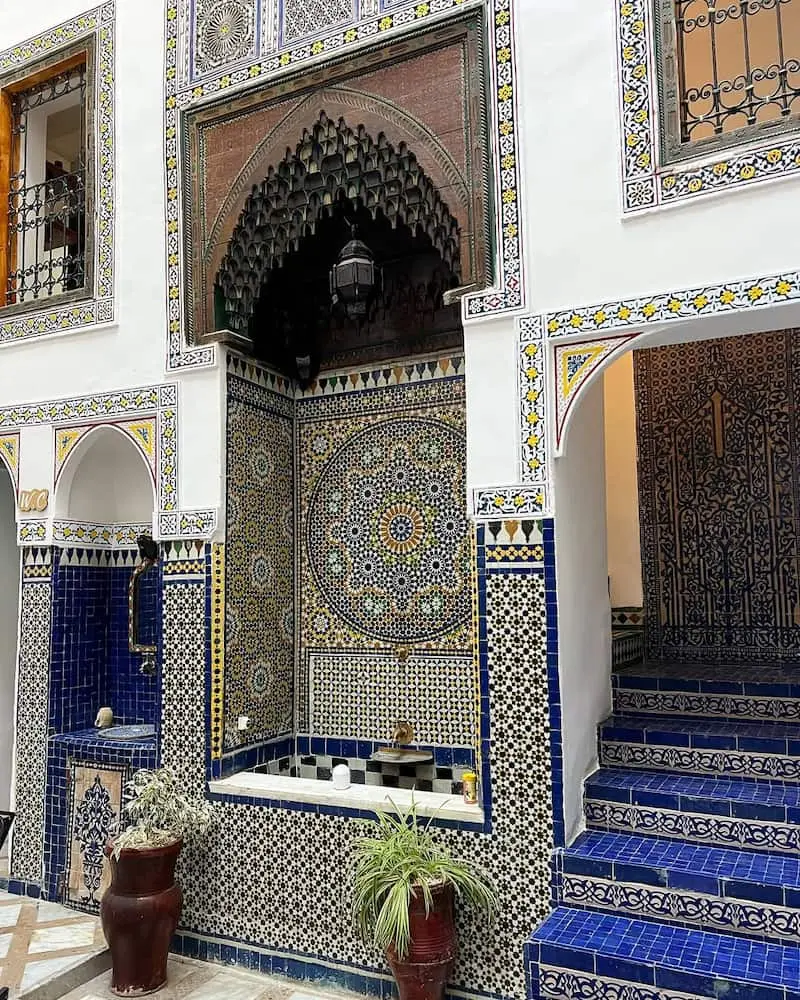Nestled in the heart of Morocco, Fes (also spelled Fez) is not just a city — it is a living museum of Moroccan history, tradition, and spirit. With its ancient alleys, intricate architecture, and deep cultural roots, Fes remains a must-visit destination for travelers seeking authenticity and wonder.
In this article, discover where Fes is located, the great history it holds, its iconic architecture, traditional crafts, famous places like Bab Boujloud and riads, and remarkable people who left their mark on this city.
—
📍 Where Is Fes Located?
Fes is located in northeastern Morocco, about 200 kilometers (125 miles) east of Rabat, the capital city. It sits between the Rif Mountains and the Middle Atlas, giving it a strategic and historical significance. Fes is considered one of the four imperial cities of Morocco, along with Marrakech, Rabat, and Meknes.
—
🏰 A Glimpse into the Glorious History of Fes
Fes was founded in 789 AD by Idris I, the founder of the Idrisid dynasty. Over the centuries, it became a center of Islamic learning, culture, and politics in the Maghreb.
During the 13th and 14th centuries, Fes reached its golden age. It was home to the world’s oldest continuously operating university — Al-Qarawiyyin University, founded in 859 AD by Fatima al-Fihri, a woman of vision and faith.
Fes became a beacon of scholarship, art, and trade, attracting scholars, artists, and craftsmen from across the Islamic world.
—
🕌 The Architectural Treasures of Fes
Walking through the Fes el-Bali (Old Medina) feels like stepping into another century.
The city boasts narrow labyrinthine streets, ornate mosques, historic madrasas (Islamic schools), and traditional Moroccan houses with inner courtyards.
Buildings are decorated with zellige tiles, carved cedarwood, and plasterwork.
The iconic Blue Gate (Bab Boujloud) is the main entrance to the old medina and a symbol of the city’s timeless charm.
Visitors often stay in restored riads — beautiful traditional homes with central gardens and fountains, offering a peaceful oasis in the heart of the bustling medina.
—
🛠️ Workshops and Traditional Craftsmanship
Fes is Morocco’s capital of traditional crafts. The old medina is filled with workshops (souks) that preserve ancestral techniques passed down through generations:
Tanneries: The Chouara Tannery is one of the oldest in the world. From above, you can see colorful dye pits where leather is treated and dyed naturally.
Ceramics and Pottery: Fassi artisans produce stunning hand-painted plates, bowls, and tiles using blue and white designs.
Copper and brass work: Skilled metalworkers craft lamps, trays, and teapots.
Wood carving and embroidery are also proudly maintained in small family-run ateliers.
These crafts are not just souvenirs — they are living expressions of Moroccan identity.
—
🏛️ Famous Places You Must See
Bab Boujloud (Blue Gate): The western entrance to the medina, known for its stunning blue-and-green tilework.
Al-Qarawiyyin Mosque and University: Founded in 859, it is considered by UNESCO and Guinness World Records as the oldest existing and continually operating university in the world.
Madrasa Bou Inania: An architectural masterpiece with detailed carvings and a peaceful atmosphere.
Dar Batha Museum: A former palace turned into a museum showcasing Moroccan art and history.
The Mellah (Jewish Quarter): A testament to Morocco’s multicultural past.
—
🌟 Remarkable Figures from Fes
Fes has given birth to and welcomed brilliant minds and historical figures, such as:
Fatima al-Fihri – Founder of the Al-Qarawiyyin University, a pioneer for women and education.
Ibn Khaldun – The father of sociology, though born in Tunis, he studied and worked in Fes.
Leo Africanus (Hassan al-Wazzan) – A famous traveler and diplomat, educated in Fes before his journeys to Europe.
Sufi scholars and poets – Fes has been a spiritual and intellectual center for centuries.
—
✨ Why Fes Should Be on Your Travel List
Visiting Fes is not about ticking a box on your itinerary — it’s about experiencing time travel through history, art, spirituality, and human ingenuity. Whether you’re sipping mint tea in a quiet riad, walking through the busy souks, or admiring ancient architecture, Fes offers a unique and unforgettable experience.
—
Fes is more than just an old city in Morocco. It is a guardian of heritage, a cradle of knowledge, and a heart that beats with centuries of tradition. Whether you’re a history lover, a cultural explorer, or simply someone looking for authenticity — Fes will welcome you with open arms and timeless beauty.


Pingback: Moroccan Cuisine: A Culinary Treasure of the Arab World - colorsofmorroco.com
Pingback: Museums of Morocco: Exploring Art, History, and Hidden Treasures - colorsofmorroco.com